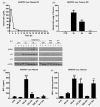Preclinical evaluation of the first intravenous small molecule MDM2 antagonist alone and in combination with temozolomide in neuroblastoma
- PMID: 30536898
- PMCID: PMC6491995
- DOI: 10.1002/ijc.32058
Preclinical evaluation of the first intravenous small molecule MDM2 antagonist alone and in combination with temozolomide in neuroblastoma
Abstract
High-risk neuroblastoma, a predominantly TP53 wild-type (wt) tumour, is incurable in >50% patients supporting the use of MDM2 antagonists as novel therapeutics. Idasanutlin (RG7388) shows in vitro synergy with chemotherapies used to treat neuroblastoma. This is the first study to evaluate the in vivo efficacy of the intravenous idasanutlin prodrug, RO6839921 (RG7775), both alone and in combination with temozolomide in TP53 wt orthotopic neuroblastoma models. Detection of active idasanutlin using liquid chromatography-mass spectrometry and p53 pathway activation by ELISA assays and Western analysis showed peak plasma levels 1 h post-treatment with maximal p53 pathway activation 3-6 h post-treatment. RO6839921 and temozolomide, alone or in combination in mice implanted with TP53 wt SHSY5Y-Luc and NB1691-Luc cells showed that combined RO6839921 and temozolomide led to greater tumour growth inhibition and increase in survival compared to vehicle control. Overall, RO6839921 had a favourable pharmacokinetic profile consistent with intermittent dosing and was well tolerated alone and in combination. These preclinical studies support the further development of idasanutlin in combination with temozolomide in neuroblastoma in early phase clinical trials.
Keywords: MDM2 antagonists; RO6839921 (RG7775); idasanutlin (RG7388); neuroblastoma; temozolomide.
© 2018 The Authors. International Journal of Cancer published by John Wiley & Sons Ltd on behalf of UICC.
Conflict of interest statement
We disclose that L. Chen and D.A. Tweddle are part of an international collaborative research consortium with Hoffmann‐La Roche Ltd. Newcastle University, Cancer Research Technology and Astex Pharmaceuticals Inc. are part of an alliance agreement since 2012 and D.R. Newell, D. A Tweddle and J. Lunec have received research support and funding from Astex Pharmaceuticals, Inc. All other authors declare no conflicts of interest.
Figures





References
-
- Matthay KK, Maris JM, Schleiermacher G, et al. Neuroblastoma. Nat Rev Dis Primers 2016;2:16078. - PubMed
-
- Ding Q, Zhang Z, Liu JJ, et al. Discovery of RG7388, a potent and selective p53‐MDM2 inhibitor in clinical development. J Med Chem 2013;56:5979–83. - PubMed
-
- Higgins B, Tovar C, Glen K, et al. Abstract A156: preclinical activity of MDM2 antagonist RO6839921, a pegylated prodrug for intravenous administration. Mol Cancer Ther 2015;14:A156‐A.
-
- Higgins B, Glenn K, Walz A, et al. Preclinical optimization of MDM2 antagonist scheduling for cancer treatment by using a model‐based approach. Clin Cancer Res 2014;20:3742–52. - PubMed
Publication types
MeSH terms
Substances
Grants and funding
LinkOut - more resources
Full Text Sources
Medical
Molecular Biology Databases
Research Materials
Miscellaneous

